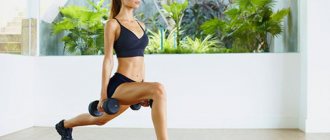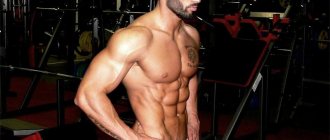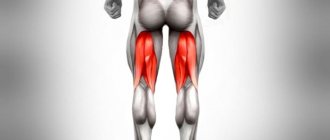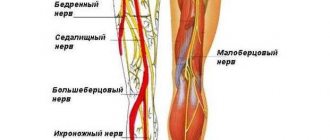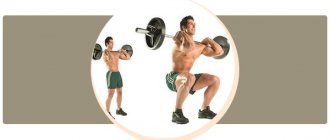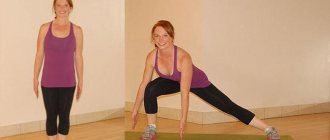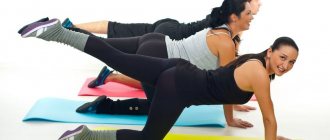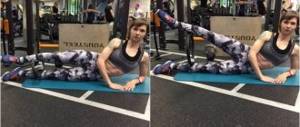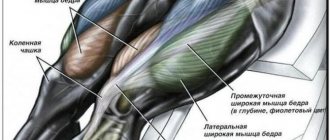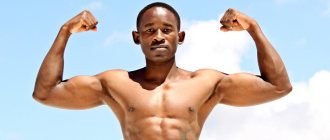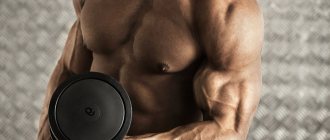Squats with a barbell on your shoulders
Read Elena's analysis, it's really detailed. Now let's go over the main points of performing squats with a barbell.
- During the exercise, you should not lift your heels off the floor - if you cannot squat low enough without lifting your heels, then you have problems with the flexibility of your ankles, and probably your hip joints
- You need to keep your back straight and not lean forward throughout the entire exercise. Follow this strictly if you don’t want various problems with the spine to appear.
- The position of the barbell on the shoulders is the safest, although at first unusual option - an arrangement in which the barbell is located quite low - not at the base of the neck, but on the rear delts. In this position of the barbell, you will automatically have to squeeze your shoulder blades together, straighten your chest and take the safest body position for a squat.
- In addition, when the bar is lower , you are less likely to “peck” your nose and fall forward - this improves not only your technique, but also reduces the load on your lower back. This is another important plus. Try placing the barbell low, get a stable position, and when you get used to it (at first it may be unusual to put pressure on the bones of the shoulder girdle), you will realize how much better your squat has become
- The grip of the barbell should be slightly wider than your shoulders - as far as the mobility of your joints allows you
- After you have removed the bar from the racks and moved a couple of steps back from them, we begin the squat. It is necessary to bend your knees slightly, at the same time move your chest forward and up and move your pelvis back a little
- Move your pelvis as if you were sitting on a chair located behind you!!!
- When lowering down, you need to inhale in the first third of the movement
- The depth of the squat should be quite low - the guideline is when your upper thighs are parallel to the floor
- Without pausing in the lower position, return to the starting position
- While lifting, exhale – also in the upper third of the movement.
Bulgarian lunges
An isolating exercise, due to consistent loading, has a visible tightening effect on the quadriceps area, without pumping or overstraining it. The difficulty is high, due to the fact that in addition to performing lunges, it is necessary to concentrate attention and maintain balance . Additionally, lunges will load the buttocks and back of the thighs.
- Starting position – the left leg rests on the support, the right leg is relaxed, put forward;
- As you inhale, lunge with emphasis on your right limb until your knee forms a 90-degree angle. The load in the foot is shifted to the heel;
- As you exhale, we return to the starting position.
More details in the video:
For good results, you need to implement 15-18 lunges on each leg in 2-3 sets with a break of a minute.
Stepping onto a support
Here we must take into account that such steps are rather pelvic-dominant exercises, however, the load on the front surface of the thigh in this exercise is quite pronounced, and this exercise is excellent for making home workouts more difficult. In order to shift the load on the muscles of the anterior thigh, it is necessary to perform steps with the platform positioned on the side.
I don’t know whether it’s worth mentioning or not, but when using this exercise in home workouts, choose the widest and strongest chair possible so as not to fall over while doing the exercise.
I had a friend who decided to perch on a stool at home with 40 kg dumbbells. The stool collapsed under him, and his friend then walked for 2 weeks as if he had been impaled, such was the discomfort in his spine.
And there is one more mistake that many make - pushing off strongly with the lower leg. Such a push-off not only reduces the load on the leg that is standing on the support, but can also provoke a sprain due to the sudden movement.
Therefore, be careful not to allow such a sudden movement - pushing away.
How to train the front of the thigh: 3 proven exercises
Pumping the front surface of the thighs very often raises questions, since this muscle group pumps quite easily and very quickly tends to become large, thereby spoiling the appearance of women’s legs. How to train this zone correctly - read in our material.
The front of the thigh in women is one of the most delicate parts of the body in the sporting direction. So, it is this zone that pumps faster than other muscles, and when weights are applied, it becomes large and slightly “bloated”. To prevent this, you need to forget about using any weights when working with the front of the thighs (we are talking about a weight of more than 5 kilograms). So, all exercises should be performed only with your own weight (or dumbbells up to 5 kg); this zone must be pumped according to the scheme: many repetitions and a fairly fast pace.
Note that you should not devote more than 2-3 exercises specifically to this part of the thigh within one workout, since it is indirectly affected in virtually all exercises on the legs.
Special squats
Stand straight, spread your legs slightly wider than your shoulders, toes pointing to the sides. Sit down a little, as if you want to sit on a chair. Stay in this position, it will become your starting position. Next, on the way out, squat even lower and stay in this position for 10-15 seconds. Next, return to the starting point.
It is necessary to perform 3 sets of 10 repetitions
Supported squats
To perform this exercise you will need support: you can use a chair or a wall. Stand straight with your legs together. As you exhale, lower yourself as if you want to sit on a chair. This is the starting position. Please note that the stomach and buttocks should be tucked in and the back should be as flat as possible.
It is worth noting that in this position (if you did everything correctly) it is quite difficult to maintain balance. So hold on to your support. Next, at the exit, do a squat of 7-12 centimeters, stay at the bottom for 15 seconds and return to the starting position.
Perform 3 sets of 10 times.
You can fully straighten your legs in the two previous positions only between approaches. Also, make sure you breathe correctly and remember that the exercises must be performed after the muscle warming complex. Rest between exercises is no longer than one minute.
Leg Raise
To do this exercise, lie on the floor with your legs straight. It is very important that the lower back is firmly pressed to the floor and does not create a deflection. Next, raise your legs up: your knees may be slightly bent. Actually, this position is your starting position. At the exit, lower your legs to your chest, bending them at the knees, then lift your legs, returning them to their starting position.
It is necessary to perform 3 sets of 15 times.
Incorporate these exercises into your leg training program. After completing them, be sure to do a little muscle stretching. Remember, even when exercising at home, your program should include exercises for all muscle groups. You can divide your workouts into zones: Monday - back and chest, Wednesday - legs, buttocks, Friday - arms. Or you can create a universal workout, in which you will pump your entire body in one session.
Watch online video Anterior thigh stretching
Bulgarian split squats
Another single-leg variation of a knee-dominant exercise is the Bulgarian split squat. To be honest, I don’t include it in my regular training, because I don’t like this exercise for three reasons.
1. Too much load on the knee of the front leg.
2. When you do it in swimming trunks, ask someone to take a photo of you from behind, you will see everything for yourself. The point is not that one buttock will be higher than the other, but that the pelvic bones will be skewed. Even from a theoretical point of view, such distortions can lead to problems, but from a practical point of view, I focus more on sensations, and the sensations from such a distortion are not very pleasant.
3. And finally the third reason. The leg with which you lean on the support is in a stupid position from a biomechanical point of view. Even an experienced person finds it difficult to maintain balance, but what about beginners?
This exercise is just from the series “Look, we came up with something new” - it looks like lunges, but one of the legs is on a raised platform - a bench, or at home on a bed or sofa.
Think for yourself, decide for yourself (c), but it is better to load the front surface of the thigh with other exercises.
The best set of exercises
1. The first and most important exercise for developing a straight thigh is squats with a barbell. This is the basis of all basic exercises, is the main discipline of triathlon, a favorite exercise of powerlifters. Let's look at the correct technique. Feet are shoulder-width apart; you can spread them wider, with your toes turned outward, but in this case the gluteal muscles will take on more of the load.
We place the barbell on the trapezius muscles and take it with a comfortable grip. We squat to such a level that the butt is parallel to the floor. When performing the exercise, do not lift your heels; your back should always be in a straight position. You should feel the muscles in your buttocks and quadriceps. To make it easier to squat, it is recommended to look between the ceiling and the wall located in front of you.
2. Front squats. An alternative to the classic squat, however, the difference lies in the technique and the muscles that take on the maximum load. In this case, the maximum load falls on the medial head. The squat technique is the same as a regular squat, but the bar is placed in front of the shoulders. The grip is cross-shaped; to begin with, I recommend training with a small weight to master the correct technique.
3. Lunge exercises to lift the buttocks, however, the quadriceps muscles are also actively involved in the work. Take dumbbells in your hands and step forward; at the initial level, you can touch your knees to the floor, but to increase the load, it is recommended to stop your knee at a distance of 15-20 cm from the floor. Can be performed with a barbell on your shoulders, as well as in a Smith machine.
4. Bulgarian lunges. A more challenging alternative to regular lunges. The technique is the same, but the difference is that the back leg is located on a hill.
5. Leg extensions in the simulator. This isolated exercise will help perfectly pump up your quadriceps. It is recommended to do 1 warm-up approach and 4-5 main ones, gradually increasing the weight.
6. Leg press. The exercise is performed lying down in the simulator. You place your feet on the platform and push it away from you, thus pumping the hamstrings and quadriceps. When changing the position of the legs, the load shifts.
7. Climbing on a step platform. Fitness exercise for pumping the buttocks and the front of the thigh. For beginners, it is recommended to perform the exercise without additional weight; for more experienced ones, you can pick up dumbbells.
Basic scheme. The main thing in the exercise
- basic pose (starting stance)
- movement “there”
- the final position is usually the position of maximum (isometric) muscle tension
- "backward" movement
- correct “entry” and “exit” from the main position. This mainly applies to all exercises when doing them with additional weights, since a barbell or dumbbells increases the risk of pulling the wrong muscle during the initial balancing act.
- the main (initial) position in the picture is that the legs are placed so wide that when squatting, three right angles are obtained. The heel of the leg that is behind comes off the floor and “looks” up. The front leg remains completely on the floor throughout the exercise.
- very important point: the body moves vertically downwards! The picture on the right is a little crooked (with incorrect technique) - the contour is drawn as it should have been: the knee “looks” down and is directed down vertically during movement
- The body is straightened: the chest is proudly straightened, the shoulders are lowered down and back. It should feel like your upper body is moving slightly backward as you move up and down.
Positioning the legs. Very important point
- First, let's look at the bottom diagram - the feet are on parallel lines A and B
- The width of parallel straight lines is at the level of shoulder width or hip width. Whatever is wider, should be placed at the level of that
- F – the leg in front is completely on the floor, the foot is NOT turned in or out
- The leg behind is on the toe, but when moving down, the heel goes straight up, as if “looking” at the ceiling
- That green cloud is a torso, with a flat butt at the back
